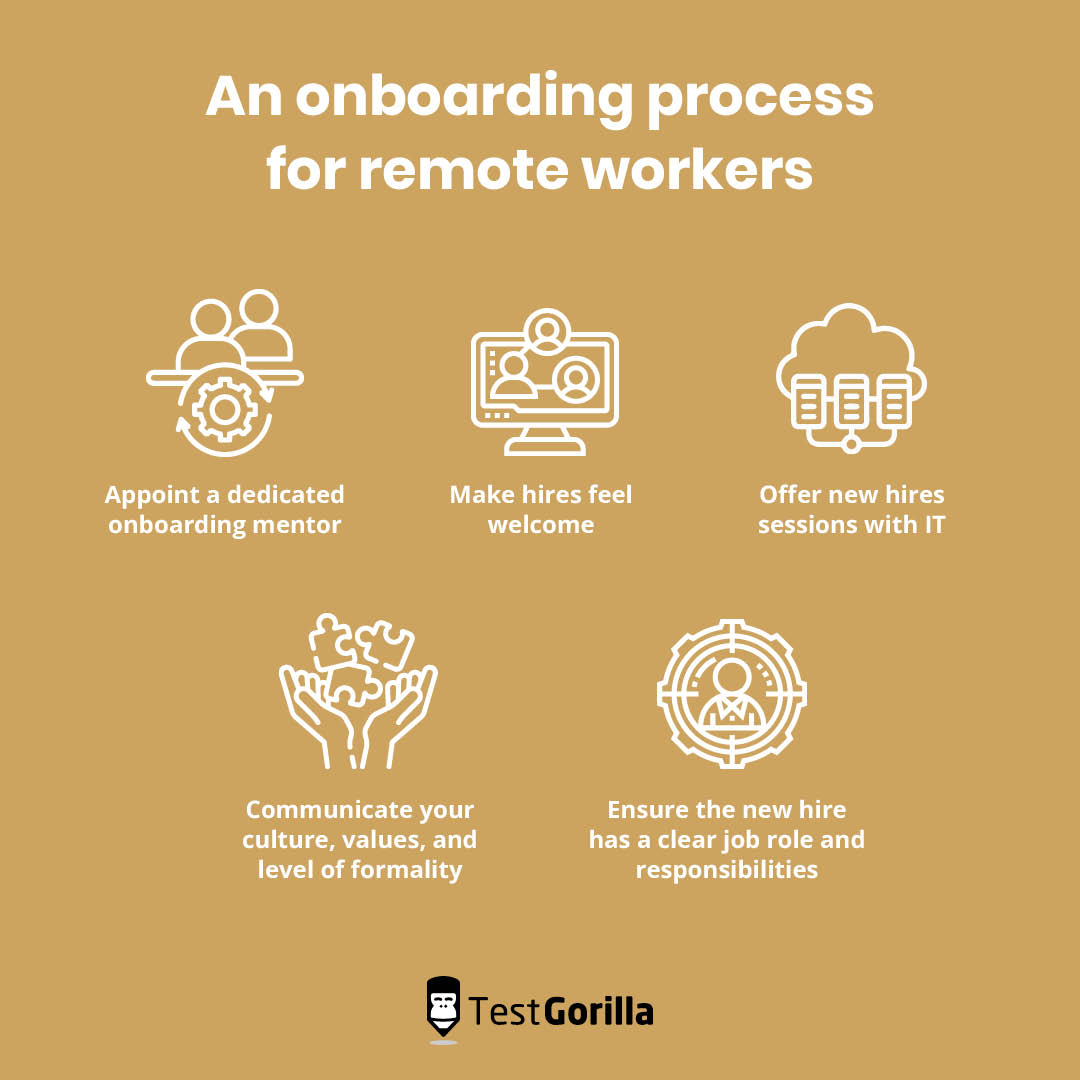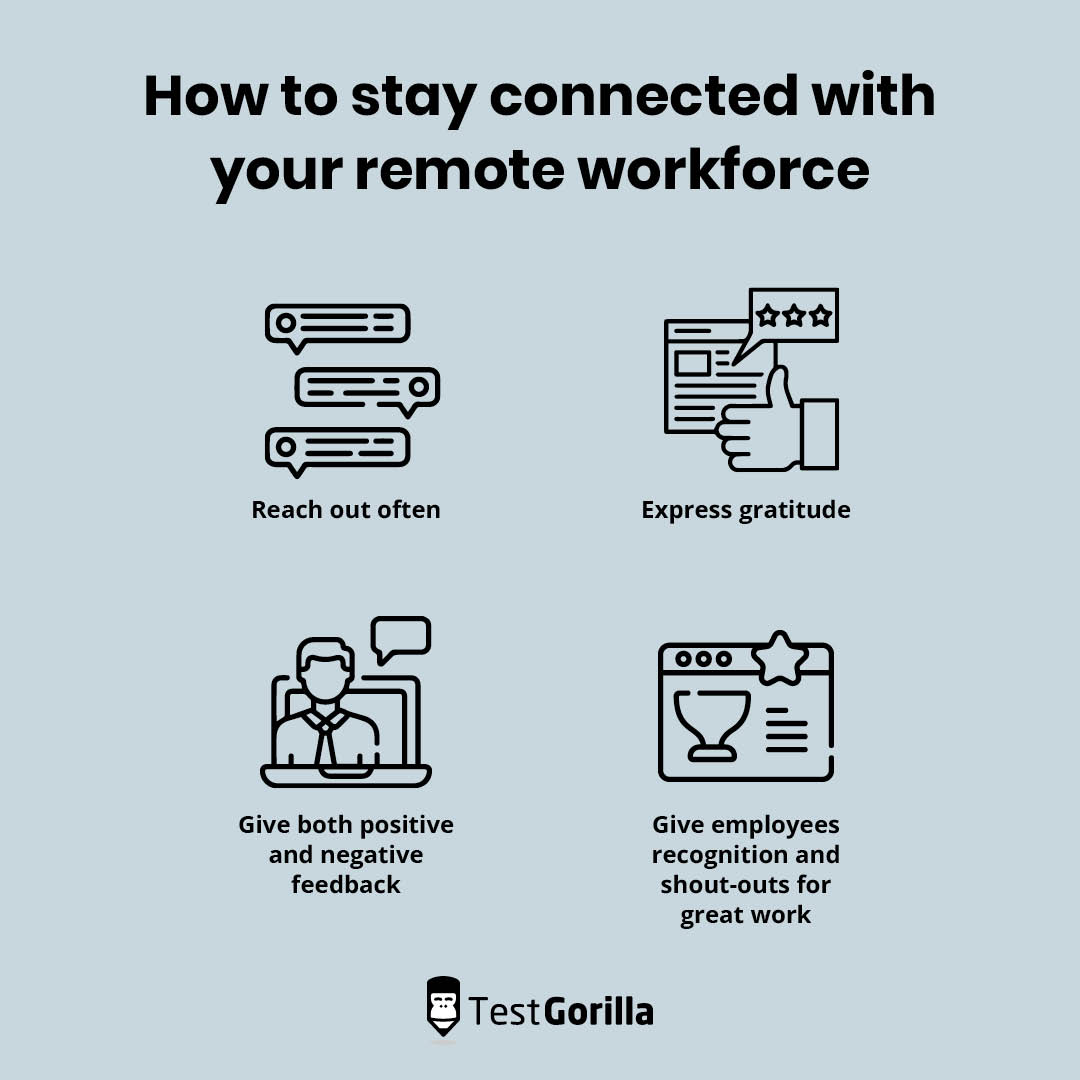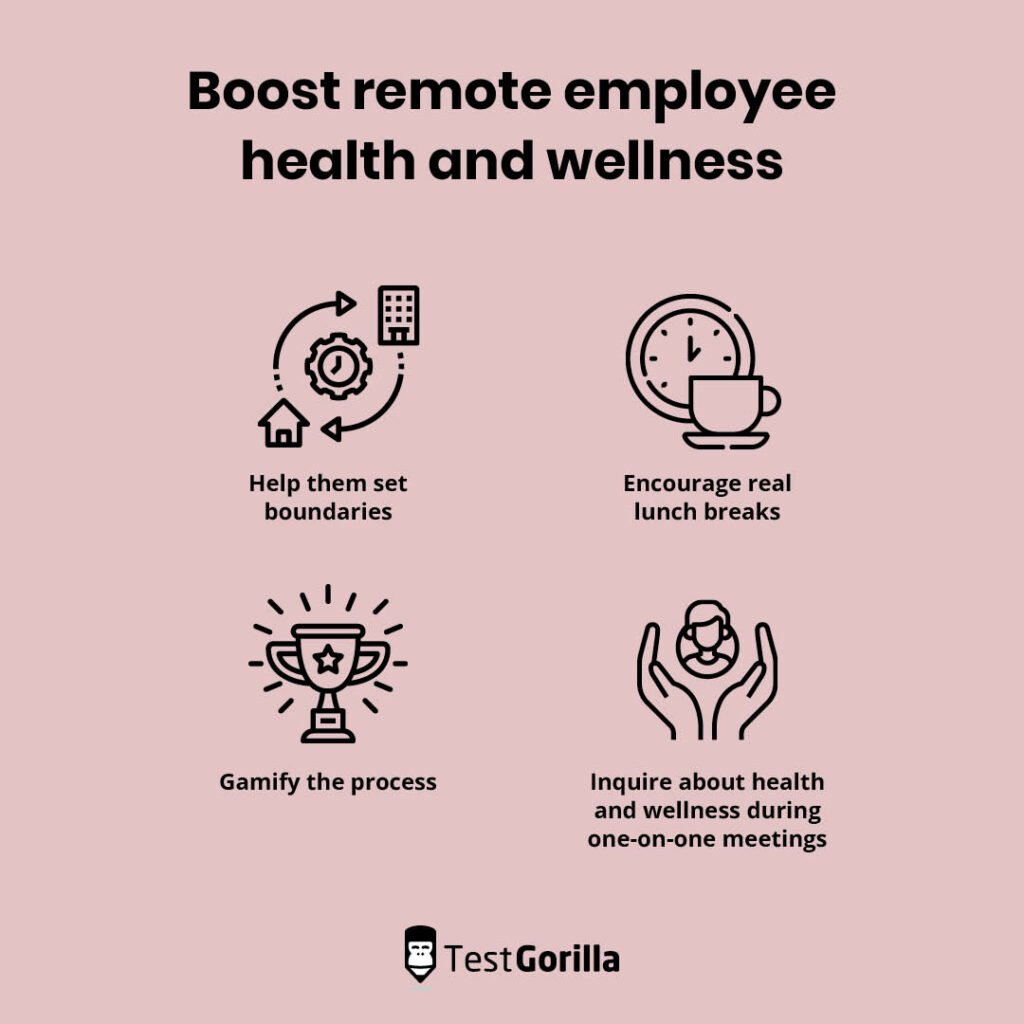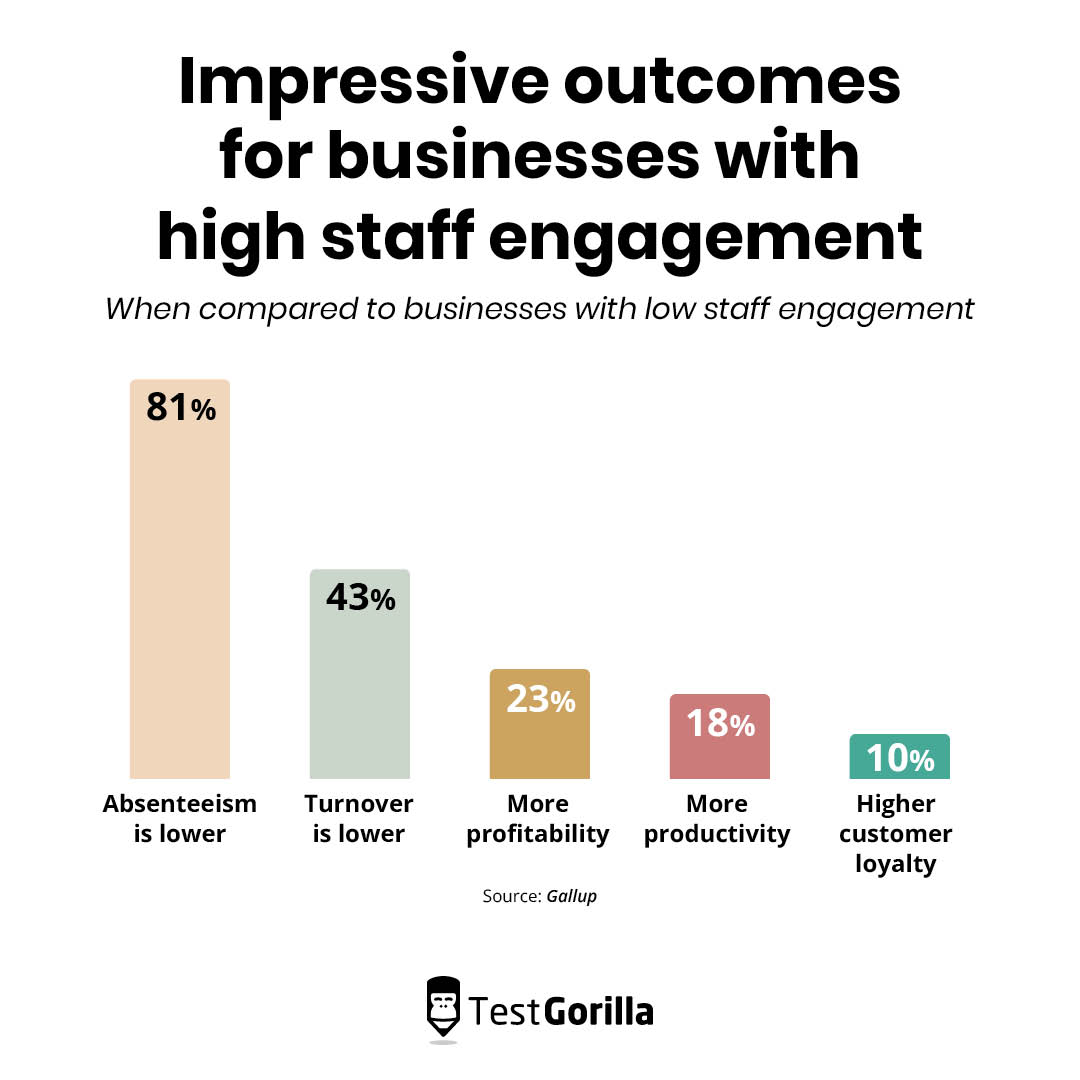Engaging remote employees: A guide for HR professionals
Remote work is the future. Employees and companies alike love it.
It provides autonomy for self-motivated employees and reduces costs for employers, among many other advantages.
But despite its many benefits, it has one major drawback. Remote employees can feel isolated or detached from the organization more quickly, impacting performance, collaboration, and motivation.
Engaging remote employees is just as, if not more, important than engaging in-office workers.
You need to proactively engage your dispersed workforces to create a remote work environment that leverages the best of all worlds.
This guide discusses the top 10 strategies for remote employee engagement, including virtual water coolers, frequent recognition, and solid growth opportunities.
Table of contents
10 proven methods for boosting remote employee engagement
Engaging remote employees effectively is no more difficult than properly engaging in-office employees.
The strategies may be different, but once you incorporate them into your processes and culture, they become natural parts of the workday.
Summary
Strategy | Description |
1. Set up remote onboarding for virtual employees | Welcome remote employees with an informative, engaging onboarding process |
2. Stay connected and make sure employees have clear responsibilities | Communicate frequently with remote employees to ensure they don’t feel isolated |
3. Hold a weekly catch-up meeting | Touch base with all employees regularly through weekly huddles |
4. Host casual hangouts, calls, and Slack boards | Facilitate socialization through virtual water coolers and chat boards |
5. Hold company-wide team-building events once or twice a year | Bring your whole team together through large company events |
6. Help remote workers set and maintain boundaries at work | Encourage positive, healthy work boundaries to reduce burnout and exhaustion |
7. Recognize top performers and encourage real-time feedback and praise | Ensure your workers get the recognition they deserve, including peer to peer recognition |
8. Support remote workers’ health and wellness | Inquire about your employees’ health and promote healthy lifestyles |
9. Offer internal development opportunities for remote team members | Engage your remote workforce by showing an interest in their professional growth |
10. Hire employees who are better suited for remote work | Assess if a candidate is suited to remote work in the early stages of hiring |
1. Set up remote onboarding for virtual employees
An employee’s first days and weeks in a new role have a large impact. Failing to make the most of this crucial time by setting them up properly and introducing them to important systems can hinder their performance.
Your onboarding process also affects their opinion of the position and the business.
The right onboarding can benefit every employee’s success, so it’s the first step for effective remote employee engagement.
Good onboarding means helping new hires adjust to a remote work style and taking the time to fully immerse them in your organization’s culture from a distance rather than just hoping it works out.
Here’s a sample onboarding process for remote workers:
Appoint a dedicated onboarding mentor: A mentor gives the employee someone specific to direct questions and comments to
Make hires feel welcome: Offer onboarding packages and send welcome messages on Slack
Offer new hires sessions with IT: Help them set up video conferencing systems, communication channels, and any other necessary company programs
Communicate your culture, values, and level of formality: Appoint a culture mentor similar to the onboarding mentor so that new hires can direct all inquiries about company culture to one specific person
Ensure the new hire has a clear job role and responsibilities: Give all remote employees clear responsibilities from day one (more on this in the next section)
Remote onboarding is only difficult because many businesses aren’t accustomed to it. Once you have a concrete system in place and remote onboarding becomes a normal part of the company, it’s just as easy as in-person onboarding.
2. Stay connected and make sure employees have clear responsibilities
There’s little worse than feeling alone and forgotten in the workplace. This problem looms even larger for remote employees, so it’s important to take the time to frequently and clearly communicate with them.
A recent study by Airspeed showed that this disconnect is the number one reason remote employees leave their positions.[1]
Here are a few ways to better connect with your remote workforce:
Reach out often
Express gratitude
Give both positive and negative feedback
Give employees recognition and shout-outs for great work
It’s important to show remote workers that you value them just as much as if they were sitting next to you in the office.
You can help set up a culture where this behavior is encouraged and rewarded. For example, you could run training for line managers and discuss this behavior in regular 1:1 meetings.
Another way to properly connect and communicate is by setting clear role responsibilities.
Setting clear goals and expectations reduces confusion and frustration, which helps keep remote employees engaged and boosts their confidence, motivation, and morale.
Just don’t go overboard and start micromanaging your remote employees. Clear responsibilities help them succeed, but nitpicking and excessive control can demotivate them and cause stress.
When you trust your workers, you nurture their trust in you and your organization.
Read more in our blog post about why trust is important in the workplace.
3. Hold a weekly catch-up meeting
A great way to engage remote employees is to include them in regular team meetings via a weekly huddle.
Unfortunately, remote employees are likely to feel distant and detached from regular work practices, decisions, and events. A weekly huddle also reminds them that they’re a vital part of the team.
Here are a few things to include in the huddle:
Important work and project updates
New guidelines and policies
Reports on general work progress
A simple catch-up
A weekly check-in keeps remote employees in the loop and ensures they stay a part of normal work life.
Spend part of it communicating to humans rather than workers – build a team rather than a collection of people working together. Ask them about their home office, relate to them, and encourage all team members to join in.
Nothing is more powerful for engaging remote employees than acknowledging their humanity.
Here at TestGorilla, we hold weekly stand-ups to praise and recognize all of our workers. This type of recognition helps engage remote employees and brings everyone closer together as a unified team.
This encourages peer to peer recognition and brings remote teammates closer (more on that later).
4. Host casual hangouts, calls, and Slack boards
Casual conversation is one of the main things missing from remote work life. Remote employees may find that every chat is scheduled on a calendar.
In fact, one of the most common arguments against remote work is its lack of office culture and socialization.
This is another issue that you can resolve with due attention.
You can facilitate casual chats by hosting virtual hangouts and promoting conversations in a relaxed Slack board.
These are places where your team can come together and have a casual chat about work or life – kind of like a water cooler chat in the office. They enable colleagues to meet and network with one another rather than just communicate with their boss.
At TestGorilla, we like setting up “coworking calls” that team members can drop in and out of whenever they want to talk. We use them to:
Ask questions and resolve small problems
Have a quick brainstorming session
Ask quick questions about company policies and guidelines
Work alongside each other and body double
Body doubling is a practice in which two or more people work near each other on different tasks to boost productivity, focus, and motivation. It’s an especially effective strategy for neurodivergent people.
You can also add smaller breakout rooms within a larger call to foster close social interaction between teammates.
5. Hold company-wide team-building events once or twice a year
Large, company-wide team-building events are great for bringing together on-site and remote employees alike.
These events can be vacations, large parties, or travel for charity.
Given the size of these events, they can only reasonably happen around once or twice a year. When they do happen, they create a monumental impact on employee engagement and nurture a strong bond between employees and the organization.
They also promote positive relationships with colleagues, solid teamwork, innovation, and creativity.
We have a big team-building event once a year. In 2022, we all went to Barcelona.
This trip included work-related and off-the-cuff activities.
Our work activities were different for each department. For example, the marketing department had an “Ask Me Anything” with the new head of marketing.
There were also great speeches from the C-suite for the whole organization.
On the casual side of things, we held a city-wide scavenger hunt, a pool party, a sailing event, active guided meditation, and even a night out arranged by our LGBTQIA group.
Events and trips like this can be a lot to organize, arrange, and execute, so they can’t happen too frequently. But they impact engagement and morale so much that they’re worth all the effort.
These team-building trips are one of our top ways to boost morale at work.
6. Help remote workers set and maintain boundaries at work
One of the toughest things about maintaining remote workers’ engagement and motivation is setting and maintaining boundaries.
It sounds like a workaholic’s dream. You can get work done at any time? Every day? But this behavior can be harmful.
Not having proper work boundaries can lead to exhaustion, burnout, and quiet quitting. Employees can end up taking on things that aren’t their responsibility, working long past their normal hours, and logging in on weekends “just to check on things.”
As HR, you can engage remote employees by helping them set and maintain work boundaries:
Make it a policy for employees to communicate and reach an agreement on their boundaries
Communicate needs and issues through 1:1 meetings before they turn into problems
Discourage work outside work hours, including reading and responding to work emails over the weekend
Enable your employees to share their workload with software that helps them delegate tasks
Encouraging your remote employees to set healthy work boundaries boosts their performance, energy levels, and opinion of the company.
Workers’ opinion of your organization also reaches into your hiring initiatives because a business that promotes healthy work boundaries is an attractive place to work.
For an in-depth guide on helping your people with work boundaries, check out our blog post on setting boundaries at work.
7. Recognize top performers and encourage real-time feedback and praise
To engage remote employees effectively, you must give real recognition, feedback, and praise. A top reason for remote disengagement is feeling isolated and unrecognized.
A survey by Officevibe found that 69% of employees would work harder if their efforts were appreciated.[2] The same survey also found that 4 out of 10 employees are actively disengaged when they receive little or no feedback.
In this day and age, when people do so much online, there’s no reason that a top performer has to feel unrecognized, no matter where they get their work done.
Here are some top ways to encourage recognition for remote employees in your organization:
Create a Slack board specifically for recognition, praise, and weekly wins
Give shout-outs during your weekly huddles
Foster a culture of frequent, immediate recognition
Post spot awards and praise for remote employees on your social media page
Encourage peer to peer recognition to build relationships and boost collaboration
Building peer to peer recognition into your company culture makes this practice second nature. In a culture like this, top performers receive praise from everyone who works with them, even when you don’t actively recognize employees.
For more information on creating a company culture like this, read our article on peer to peer recognition.
8. Support remote workers’ health and wellness
Your in-office employees’ health and wellness determine their happiness, engagement, performance, and overall well-being. Remote employees are no different.
In fact, remote employees may be especially vulnerable to mental health effects because they often have an “always on” mindset that could lead to working more hours than traditional office workers.
Promoting health and wellness helps you look after your remote employees and mitigate working-from-home depression.
Here are a few suggestions to boost employee wellness:
Help them set boundaries: Healthy work boundaries benefit physical, emotional, and mental health
Encourage real lunch breaks: Downplay a culture where you quickly eat a sandwich over a keyboard – promote a real break instead
Gamify the process: Have a scoreboard for things like drinking water, taking walks, and eating vegetables
Inquire about health and wellness during one-on-one meetings: Ask about your people’s health and hobbies, and don’t forget a simple “How have you been lately?”
Nurturing health and wellness especially helps support working parents operating out of a home office.
It’s common for working parents to be remote or hybrid employees because they prefer flexible working arrangements to better care for their children and balance their life demands.
Working parents appreciate inquiries into their health and work-life balance, so don’t be afraid to ask them frequently how they’re doing and if the business can help.
9. Offer internal development opportunities for remote team members
Remote employees can easily become detached from the organization if they feel like they’re doing their work but it’s not getting them anywhere.
Learning, development, and career growth are all key aspects of engaging remote employees. They will be more motivated and loyal if they see they can progress in their career with you.
Data backs this claim up, with two separate LinkedIn studies showing the following:
Organizations that excel at internal mobility retain employees twice as long
94% of employees say they would stay with a business longer if it invested in their learning and development
Displaying interest in an employee’s professional future shows them that you value, believe in, and see a great future for them.
Help your remote employees build a professional development plan so that they can put their plans and goals on paper.
This builds strong trust between your business and your employees because it provides a way to get hands-on, inquire about their goals, and help them devise a strategy to reach their objectives.
Read about this strategy in depth in our post on building a professional development plan.
10. Hire employees who are better suited for remote work
It’s true that some people are suited to remote work more than others and naturally possess engagement that others don’t.
Using pre-employment skills testing, you can assess a candidate’s fit for remote work.
Use personality and motivation tests to gauge an applicant’s ability to adapt to this style of work. It’s not for everyone!
Here are a handful of useful tests for determining if a candidate is well suited to remote work:
Test | What it tells you |
Explores the main motivators for a candidate and if they are self-motivated enough for remote work | |
Assesses a candidate’s extroversion, emotional stability, conscientiousness, and agreeableness | |
Shows you the candidate’s core beliefs and worldview | |
Gives you insights into a candidate’s source of energy, the way they process information, and the kind of lifestyle they prefer | |
Determines whether the employee is a good company culture add (especially useful for 100% virtual teams) | |
Assesses how well a candidate can understand instructions, which is essential for remote work |
This process isn’t only useful for new hires – these tests can also be used for employees looking to change job roles.
Hiring an ideal remote candidate from the start eases your engagement efforts and makes their adjustment and work-life balance more manageable.
Why do you need to proactively engage remote employees?
Arguably, the biggest argument against remote work is that employees experience anxiety and social isolation.
Ryan Felix, a co-founder of Altbe, says many remote workers complain about isolation and anxiety. He believes they’re losing social confidence in real interactions.
A Forbes article discusses the unfortunate frequency at which remote workers feel left behind and ignored.
These sources aren’t wrong – they’re the reason we need to proactively engage remote employees.
Why not just ditch remote positions completely? Because employees demand them.
In two different surveys, CareerBuilder found that remote positions receive seven times more applications, and 83% of candidates would prefer to work for businesses offering flexible work schedules. Only 5% of workers said they’d like to return to in-office work.
Implementing these engagement methods results in happier, more social remote employees and greatly benefits the entire company. Disengaged employees cost organizations around $450bn to $550bn each year.
According to Gallup, only 15% of employees worldwide are engaged. The same study compared highly engaged companies with companies that had low engagement and found that the highly engaged businesses had:
81% lower absenteeism
43% less turnover
23% more profitability
18% more productivity
10% higher customer loyalty
From profitability to retention to productivity, engaged employees affect every major part of your business.
What’s more, high employee engagement and flexible work arrangements strengthen your company brand and make you attractive to potential candidates.
Engaging remote employees is well worth the effort
Understanding how to engage remote employees takes a little time to get just right, but it pays dividends.
Engaging remote employees is crucial to building long-term relationships with your people when you don’t meet in person often. It boosts performance and motivation and lets your workers know they’re valued.
For more information on handling flexible working arrangements, check out our guide on the hybrid office model.
Use our Reading Comprehension test to assess a remote candidate’s ability to process written information and draw appropriate conclusions.
Source
“Remote Work Culture Insights”. (March 2022). Airspeed. Retrieved December 13, 2022. https://join.getairspeed.com/deeper-cause-great-resignation/
Officevibe Content Team. (October 7, 2014). “Statistics on the importance of employee feedback”. OfficeVibe. Retrieved December 13, 2022. https://officevibe.com/blog/infographic-employee-feedback
Related posts
You've scrolled this far
Why not try TestGorilla for free, and see what happens when you put skills first.
Latest posts
The best advice on pre-employment testing, in your inbox.
No spam. Unsubscribe at any time.

Hire the best. No bias. No stress.
Our screening tests identify the best candidates and make your hiring decisions faster, easier, and bias-free.
Free resources
This checklist covers key features you should look for when choosing a skills testing platform
This resource will help you develop an onboarding checklist for new hires.
How to assess your candidates' attention to detail.
Learn how to get human resources certified through HRCI or SHRM.
Learn how you can improve the level of talent at your company.
Learn how CapitalT reduced hiring bias with online skills assessments.
Learn how to make the resume process more efficient and more effective.
Improve your hiring strategy with these 7 critical recruitment metrics.
Learn how Sukhi decreased time spent reviewing resumes by 83%!
Hire more efficiently with these hacks that 99% of recruiters aren't using.
Make a business case for diversity and inclusion initiatives with this data.
























